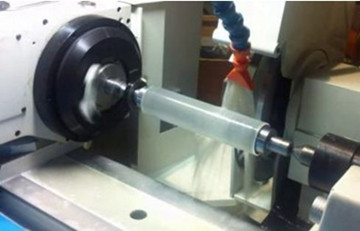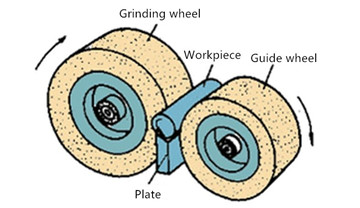What is the difference between high efficiency centerless cylindrical grinding and ordinary cylindrical grinding?
Ordinary cylindrical grinding
Ordinary cylindrical grinding uses the center holes at both ends of the workpiece to support the workpiece between the headstock and tailstock center of the grinder. During grinding, the workpiece rotates under the drive of the main shaft, and the grinding wheel makes lateral feed.
Centerless cylindrical grinding
Centerless cylindrical grinding has no headstock and tailstock. Instead, the workpiece is supported by a pallet and a guide wheel, and the grinding wheel is used for grinding. The centerless grinding method is composed of three mechanisms: grinding wheel, adjusting wheel and workpiece support. The grinding wheel is actually used for grinding. The adjusting wheel controls the rotation of the workpiece and makes the workpiece feed speed. The workpiece support is grinding. Support the workpiece when cutting. Centerless cylindrical grinders have higher productivity. It is mostly used in mass production and is easy to realize automation.
The characteristics of centerless cylindrical grinding compared with ordinary cylindrical grinding
1. Continuous processing, no need to retract the tool, short time for clamping the workpiece, and high productivity.
2. The bracket and guide wheel positioning mechanism has better support rigidity than the center and center frame mechanism of ordinary cylindrical grinding machines, and the cutting amount can be larger, and it is beneficial to the processing of slender shaft workpieces, and it is easy to realize high-speed grinding and powerful grinding.
3. The workpiece of the centerless cylindrical grinder is positioned on the positioning mechanism by the outer circle, and the grinding amount is the allowance on the diameter of the workpiece. Therefore, the wear of the grinding wheel, the compensation of the feed mechanism and the repeated positioning accuracy error of the cutting mechanism affect the diameter and dimensional accuracy of the part. Only half of the ordinary cylindrical grinder, no center hole is required, and easy to automate the loading and unloading in advance.
4. The wide-wheel centerless grinding machine can adopt the pass-through mechanism to increase the machining allowance each time, and it can grind complex profiles in sequence or multi-wheel grinding during plunge grinding, with high productivity and wide application range.
5. The centerless cylindrical grinder does not have a mechanism to ensure the relative position accuracy (coaxiality, perpendicularity, etc.) of the ground surface and the non-ground surface, and the roundness is poor when grinding the circumferential intermittent outer surface.
6. The grinding surface is prone to odd roundness. If it is larger, it will often cause the illusion that the measured size is smaller than the maximum physical size, which will affect the assembly quality and work performance.
7. The adjustment of the machine tool is complicated and time-consuming. Every time a workpiece with a different diameter is replaced, the height of the bracket, the distance and the related process parameters need to be adjusted. Therefore, it is difficult to adjust the technology and is not suitable for small batch and single-piece production.


